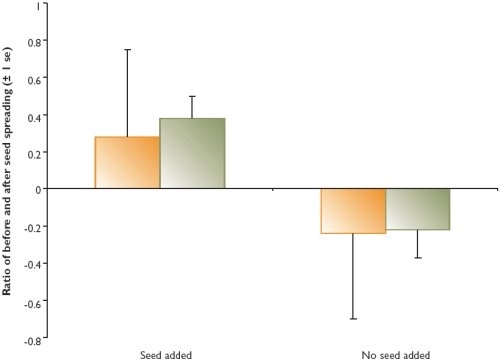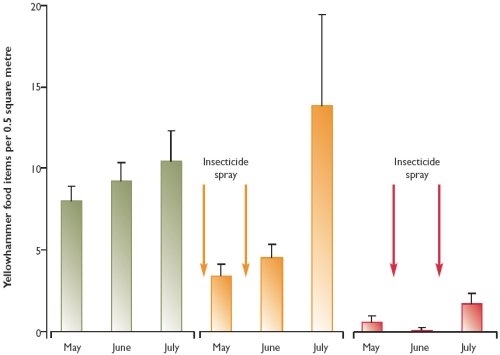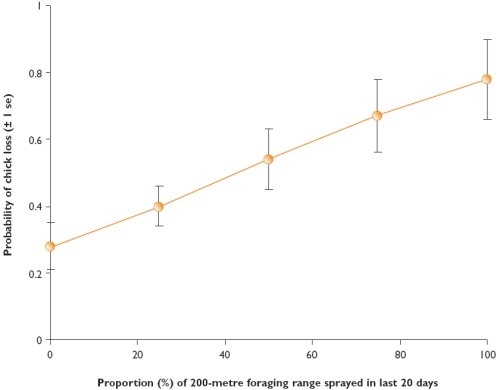Key findings
- Seed used as food for songbirds is in short supply by late winter.
- Late applications of insecticide (late May and June) can eliminate invertebrate food supplies for farmland birds.
- Early insecticide applications are less destructive allowing some recovery.
- There is a relationship between insecticide applications and lower breeding success of farmland birds.
- An insecticide application within 200 metres from a nest site may reduce breeding success by up to 20%.
We have shown that the survival of grey partridge chicks depends on an adequate supply of invertebrate food items, many of which in turn depend on weeds. Consequently insecticide and herbicide use can indirectly affect chick survival through removal of their food. Other farmland birds are likely to show a similar response and, so far, this has been proven for the corn bunting. Food supply in winter may also affect bird over-winter survival and subsequent breeding success. Many farmland birds, including gamebirds, feed on weed seeds in winter, and the supply of these depends on weed control in the previous crop and subsequent cultivations.
Changes in farming, such as the adoption of GM technology or the introduction of a new pesticide, can consequently have a substantial impact on bird numbers, even though the pesticides are not directly toxic. The Pesticides Safety Directorate of Defra funded this project to look at the indirect effects of pesticides on farmland birds. A major part of the study was a field experiment on three farms in which food supplies in winter and summer were manipulated so that the impact on bird numbers could be measured.
On each farm we set out three experimental plots. Each plot was 100 hectares. One was provided with extra seed in winter; a second was treated with extra insecticide in summer; and the third had both extra seed and extra insecticide. These allowed us to look at the effect of more food in winter and reduced (invertebrate) food in summer. Our own entomology staff measured the availability of seed and invertebrates, while staff from the Central Science Laboratory (CSL) counted the birds. The bird counts focused on yellowhammers as this species was the most numerous.
The impact of winter food supplies
We broadcast 36 kilograms per hectare of seeds palatable to songbirds, but small enough to deter pigeons, across the treatment areas three times during the winter. Birds were counted through the winter and the data analysed in two ways. The first looked at the short-term response to extra food supplies, and the second examined whether the extra food increased their numbers over the winter. The response varied between farms, but generally chaffinches, linnets and yellowhammers preferred those blocks where extra seed had been spread as was expected from modelled predictions (see Figure 1). However, only yellowhammer density increased through the winter. The abundance of weed seeds also declined through the winter on two of the farms and, although higher at the other, were still too low to attract and hold farmland birds. Most fields had very low densities of weed seed, confirming that this important food source is in short supply as a consequence of modern farming methods.
Figure 1: Ratio of numbers of yellowhammer pre- and post-seed application for the two treatments

The impact of summer food supplies
To reduce invertebrate abundance, insecticide inputs were increased by adopting a worst-case scenario for pest infestations so the timings of the applications reproduced what could occur in practice. The number of extra insecticide treatments also varied between the study sites, with the fewest being applied in Hampshire. As each block contained a range of crops the whole of the treatment blocks were not sprayed at one time and, as a consequence, birds nesting within the blocks always had access to untreated areas. This reduced the effect of the treatment, but was more realistic.
The impact of the insecticides on invertebrate abundance and the relative abundance of individual species ('the community composition') varied markedly between the crops. The abundance of those invertebrates most preferred by farmland birds showed considerable variation between the sites. For example, at the Hampshire site, oilseed rape was the most invertebrate-rich crop, whereas spring barley and winter wheat were the poorest. We found that the reverse was true at the Yorkshire site. Similarly, at the Lincolnshire site, spring barley was one of the better crops for invertebrates. The root crops were consistently poor sources of invertebrates.
The results indicate that crop management at each site may be the over-riding factor. Looking more closely at each crop we found that if insecticides were applied to winter wheat in early May and June this reduced the yellowhammer food by approximately 50%, but allowed some recovery by July (see Figure 2). Applications in late May and June almost eliminated invertebrate food supplies. In oilseed rape, insecticides are commonly applied in April, but only four applications were applied in April was there any effect on invertebrates in June and July.
The analysis comparing community composition showed that the higher insecticide inputs reduced some invertebrate groups in the winter cereals. However, others (the true bugs and small spiders) were more abundant in the high-insecticide areas. These are highly mobile and may have re-entered the crop after spraying and multiplied in the absence of their predators. For this reason, in oilseed rape the invertebrate groups (comprised mainly of pests and small rove beetles) were higher in number in the areas with greatest insecticide inputs. Similarly in sugar beet, the more mobile invertebrates were more abundant in areas of high insecticide input. We looked at the diet of yellowhammer chicks but found that the insecticide treatments caused no change in the type of invertebrates that they consumed.
Figure 2: Density of invertebrates preferred by yellowhammers in winter wheat for the unsprayed fields and for those sprayed with insecticides

Staff from CSL examined whether the insecticide applications were affecting the breeding success of yellowhammers. To achieve this they calculated the proportion of the area sprayed within 20 days from hatching for a 200-metre radius around each nest (which represented a typical foraging range) and compared this with various measures of breeding success. A significant relationship was found between the proportion of the area sprayed and the number of chicks surviving to fledge (see Figure 3). Thus if all the area were sprayed around the nest this would reduce the population growth rate by 20%. They also examined what the population growth rate would be given the current levels of invertebrate food found on the farms. This revealed that to maintain the breeding density of yellowhammers at least three times as many invertebrates would be needed.
Figure 3: Predicted relationship between the proportion of foraging range sprayed with insecticide and the probability of chick survival being reduced

Other farmland songbird chicks also depend on an adequate supply of invertebrates for their survival and similarly are likely to suffer if this is not available. There is currently no overall indicator that can be used to determine whether sufficient food supplies exist. However, the Trust has developed an index for grey partridge chick food based on our Sussex study. Given that the diet of grey partridge chicks is similar to many farmland songbirds, it provides an indication of food supplies. This also shows that food supplies for grey partridges are typically three times lower than the critical threshold needed to ensure a stable population.